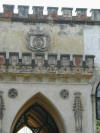Corps truck park
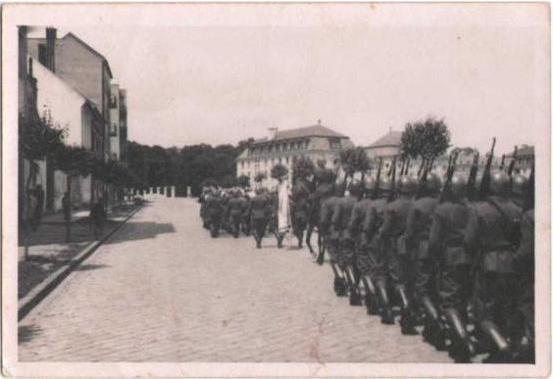
The officer leading troops on horseback with a flag at the start before the palace, built by primas of Hungary Archbishop Georgius Lippay
5th May 1919 was deployed the car armory in Masaryk barracks at Legionárska street in Trenčín. Workshops later bore the name of the Motorcade. Was translated into the new barracks in Zlatovce in the sixth december the 1943rd Had 56 employees. The new organizational structure of the Slovak army was called the "Korps automobile park "
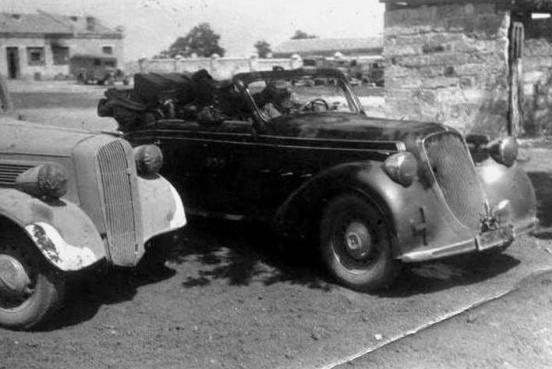
Slovak state bought in 1940 for the Army fleet of passenger cars 200 Steyr 220. Some of them were now in the garage of the existing garage in the park Archbishop's Palace. Even the government for their drive inexperienced drivers, military base presence service
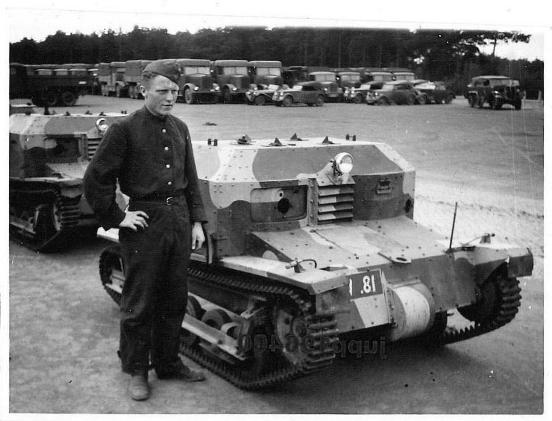
He was in the state and 3 tankettes Mk 33, heavy artillery tractor Praga T-9 and oi military trucks Walter PN. Five tankettes was in a state of the 1st JPO of Bratislava, where he served in the year 1939-40 Lt.cav. Aladár II. Ondrejkovič. On the date 18.03.1939 Slovak army took over the assets of the military administration Czechoslovak 30 tankette model. 33 which was used for training purposes.
Walter PN military trucks at the Jinonice production plant in Prague before being taken over by the army acceptance commission. The Walter PN truck with a load capacity of 2000 kg was later among the PAK military vehicles left by lieutenant cav. Aladár Odrejkovič nat On September 13, 1943, was deported from the Crimea to the hinterland of Slovakia in accordance with a secret order of the Minister of Defense of the Slovak Republic, General I. Class Ferdinand Čatloš.
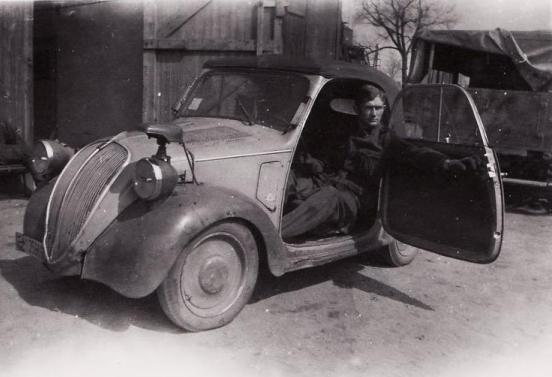
One car Fiat Topolino was included in the PAK of 1st Battalion Automotive. It was perhaps the smallest, but certainly the worst car. Despite the repairs, was again working on his.
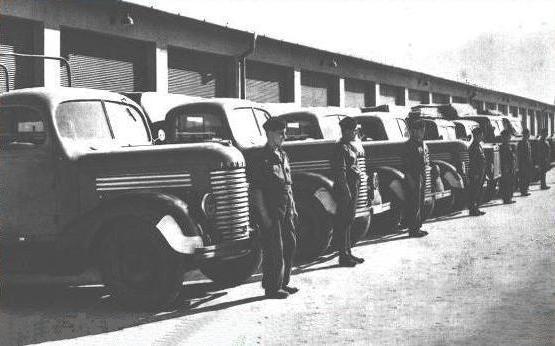
Pictured from new garages four road military trucks Praga RN of the Corps automobile park Slovak army, corresponding to 1st Automotive Battalion HQ Nitra. The fifth one is behind terrain military truck Praga RV and two off-road military trucks Tatra T27.
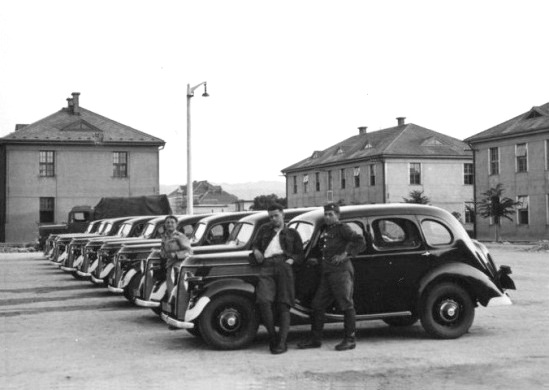
Nové osobné automobily Praga Lady Zborového automobilného parku. Por. jazd. Aladár Ondrejkovič ich osobne preberal v závodoch Praga Vysočany. Podľa jeho skúsenosti patrili medzi najspoľahlivejšia vozidlá autoparku, ale pre službu v poli boli vhodnejšie kabriolety.
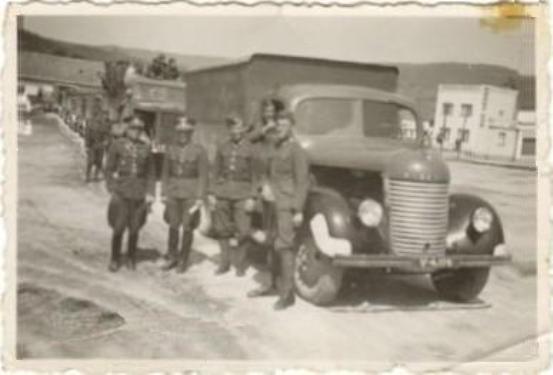
PAK of the Corps automobile park Slovak Army. The road military trucks Praga RN and off-road military trucks Škoda H (6x4).
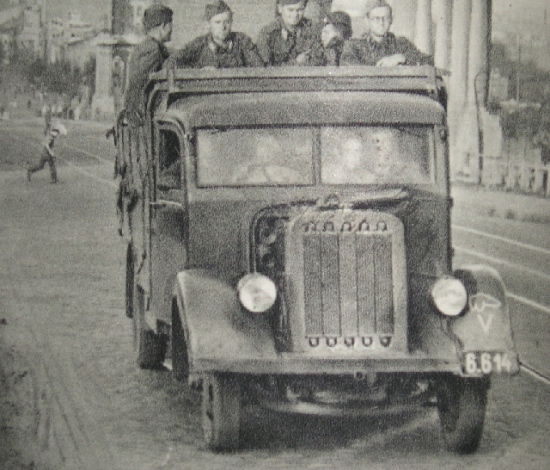
Automobile 1st Battalion for Rapid division mechanized Infantry Regiment 20 on the eastern front was used Trafic motorcade column PAK. Her commander was Lieutenant Aladár Ondrejkovič. On the car will slide PN Walter, for whom the failure to send him wrestle investigating Military field prosecutor First Lt. just JUDr. Anton Rašla.
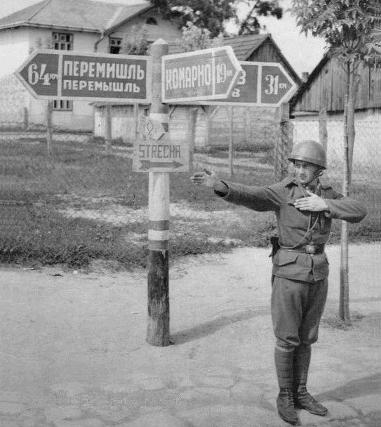
Slovak soldiers, the pace setter Operational motorcades PAK (commandor Lieutenant cavalry Aladár Ondrejkovič) of II/20th Motorized Infantry Battalion (commandor Mjr. infantry Ján Š.), 20th Infantry Regiment (commandor Mjr. infantry Ondrej Zverin), 1st Infantry Division (commandor Col. artillery Jozef Turanec) from the service on the Western Ukraine in August 1941.
On August 10, 1941, the Fast Division had 138 motorcycles (including 9 with sidecar), 201 passenger cars and 950 trucks.
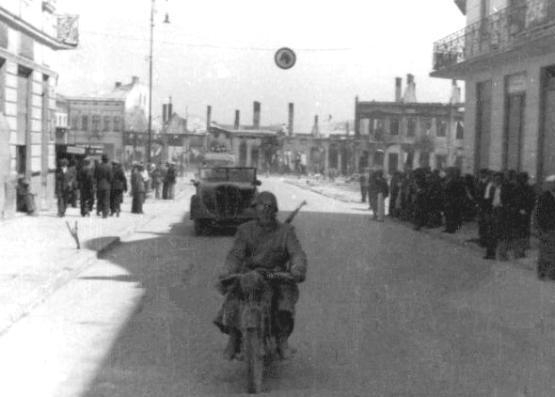
Military terrain truck Skoda 6ST6-L, command car Praga AV and motorcycle Jawa 175 Traffic automobiles column of Rapid Division in 1941. In the background of damaged buildings in the city Zolochiv in Ukraine. On the date 18.03.1939 was owned by the military administration in Slovakia 136 command cars that took Slovak army in the state.
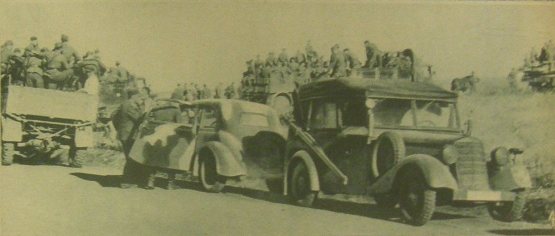
PAK vehicles with troops of the 20th Infantry Regiment of Slovak Rapid Division during the transfer to Ukraine into designated positions.
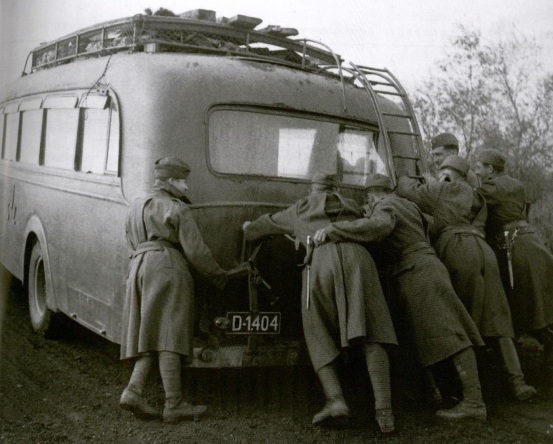
Suburban Bus Sauer of Slovak State Railways borrowed by the Army on duty at the Fast Division on unpaved roads - rogue Ukraine.
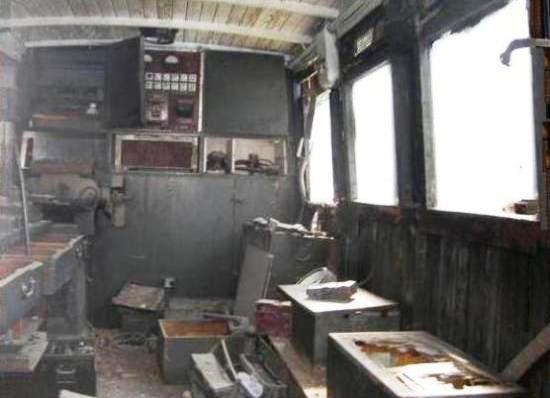
The internal space of the superstructure military Skoda Auto Workshop 6ST6L-APD-R. Auto Workshop was ranking in PAK at the end of the column.
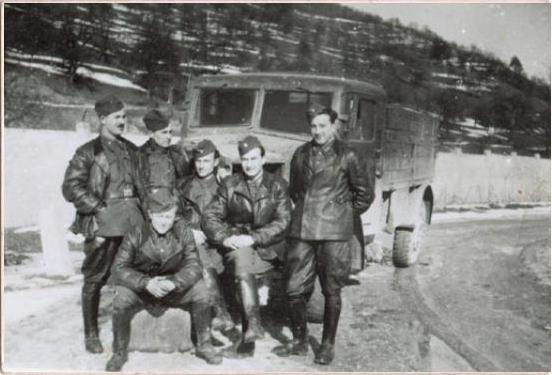
Military terrain truck Tatra T 27 of the Corps automobile fleet.
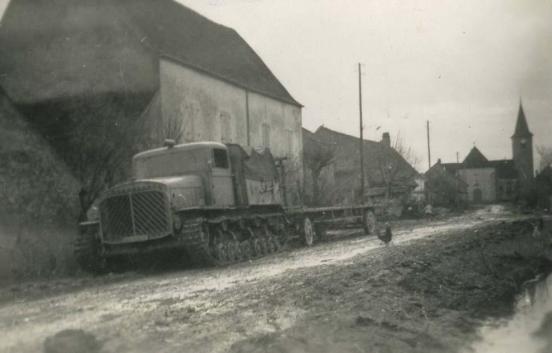
Tracked artillery tractor Praga T 9 was used except for the Wehrmacht in the Slovak army in particular to lift anti-aircraft 88mm canon FLAK 37. According to some sources, the Rapid Division had 5 Praga T-9 drag tractors available to tow 88 mm FLAK 37 cannons.
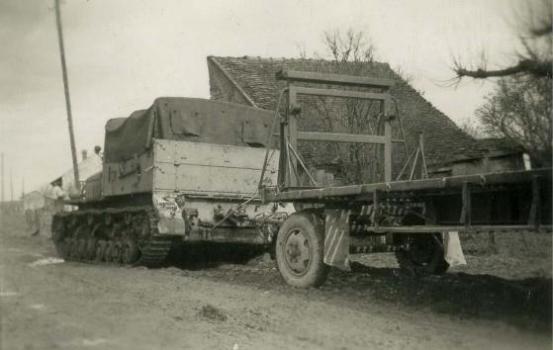
The heavy artillery tractor Praga T 9
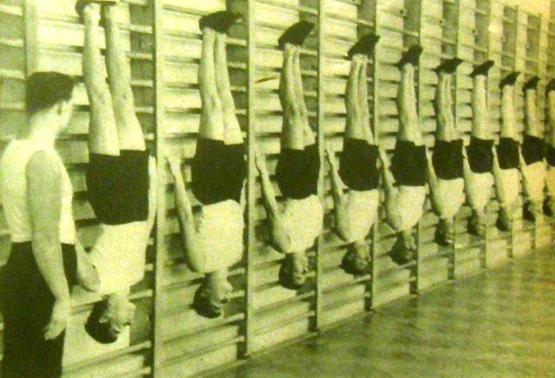
Lieutenant cavalry in reserve Aladar Ondrejkovič studied at the Military Academy in 1942-1943. In 1938 and 1939 he was assigned to service in the field. From 1941 to 1943, he was placed in service on the Eastern Front, unlike some of the academics who were not graduates of the Secondary School of Officers and did not have the rank of Officer. At the Military Academy, he has met the limits of physical fitness, including a gymnastics test with excellent results during a holiday from the Eastern Front and a short short stay in the background. However, according to the Slovak field order, the admission for applicants was at least a secondary education with a school-leaving certificate, a school for officers in the reserve and a two-year practice at a military unit with the recommendation of its commander. Exceptions to education were after 1941 for candidates, military gassists. There was a gradual erosion of the Slovak field order, under the pressure of German advisers, the Wehrmacht regulations were unofficially adopted.
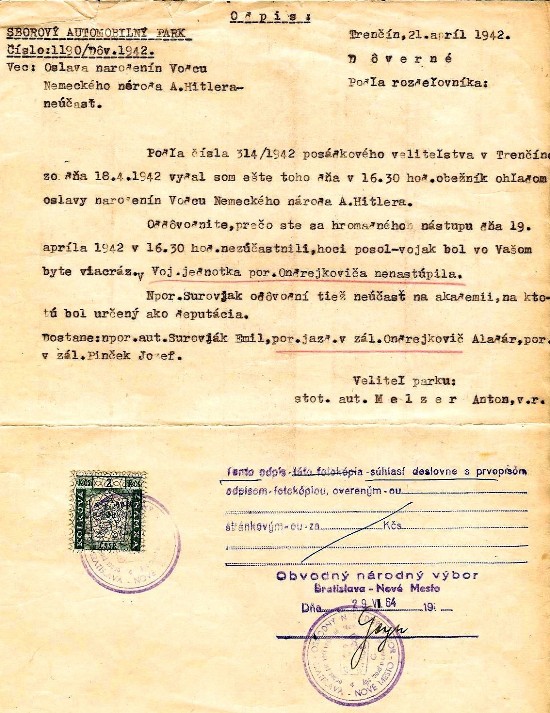
Absence of the entire military unit, including its commander Lieutenant cavalry reserve Aladár Ondrejkovč the collective taking the occasion of Hitler's birthday on 19 April 1942 in Trencin. Corps automobile park. In the meantime deployment in the field Lieutenant cavalry in reserve Aladár II. Ondrejkovič served at the Corps automobile park in Trenčín. Since the summer of 1941, including the winter of 1941-1942 until April perform duties in a field near Rapid Division.
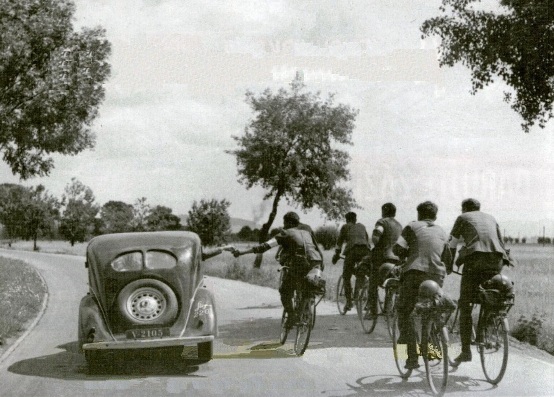
Steyr 220 Saloon fom Corps Car Park with the OAP racing team in the year 1942.

On the right is a rail transportation Automobile column PAK
_____k__pia_____k__pia_____komsomolec_1.90212_100338_23.jpg)
Wehrmacht, Romanian army and Slovak Quick brigade and then Fast Division since 1941 used to tow the damaged tanks also artillery tractor T-20 Komsomolets Soviet origin.
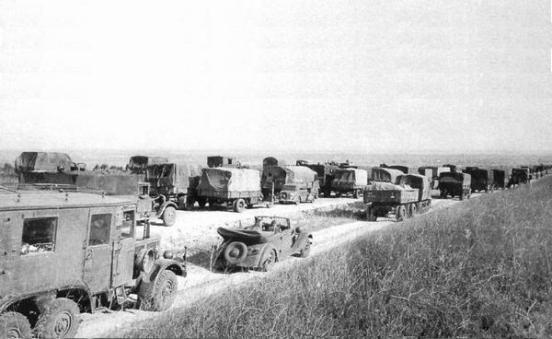
Automobile traffic column PAK transported military equipment and food from Kiev to the Azov Sea. In Ukraine and Russia have been paved road. At the time rasputice first vehicle passed overhead, the following vehicle was Serrated next to nepretrhlo thin layer of vegetation and not lost to the soaked ground. Vehicles turn, have created a wide road and 300 m. In the winter at night not stop vehicle engines for very low temperatures. Column of lorries (including ZiS-5 truck and STZ-5 tracktor) are approaching Kiev. Ukraine. September 1941
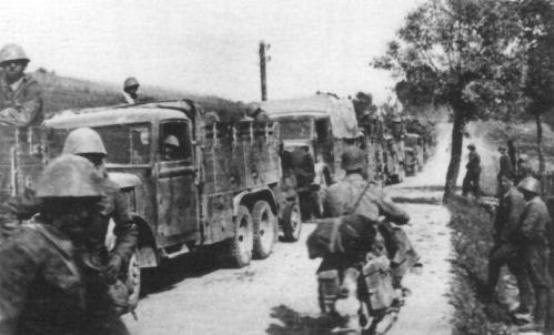
Traffic automobile column PAK. Military trucks Slovakian army Skoda H 6ST6-T and Praga RV.

The burning wooden houses in Ukraine along the shuttle route of the Fast Division with cars of PAK that left behind retreating units.
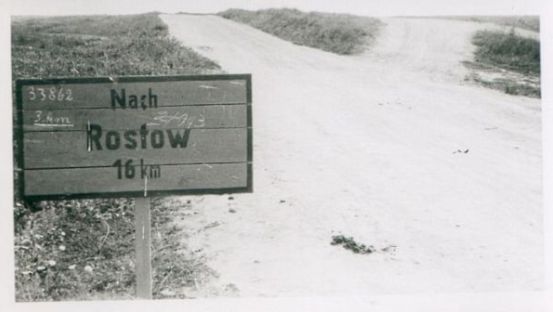
Direction of Rostov-on-Don. German troops in progress significantly underperformed Fast Division. Merit commanders had her motorcade, drivers and crews repair shop.
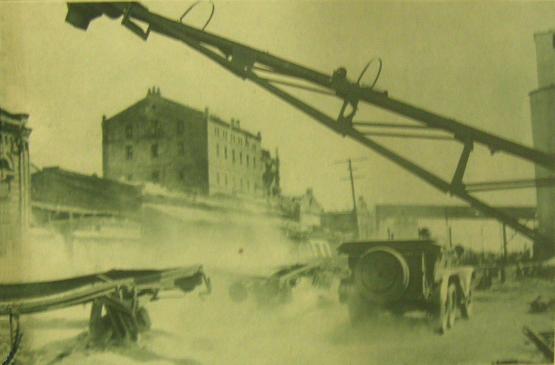
Motor Vehicles of Rapid Division in the ruins of industrial plants occupying Rostov on Don 25th July 1942.
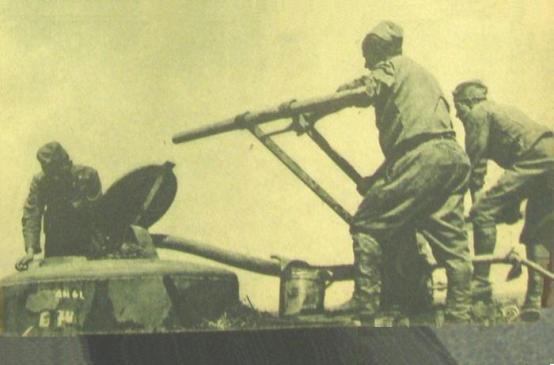
Refueling of fuel by motor vehicle PAK from Lieutenant cavalry Aladar Ondrejkovič prior to moving the Fast Division to North Caucasus.
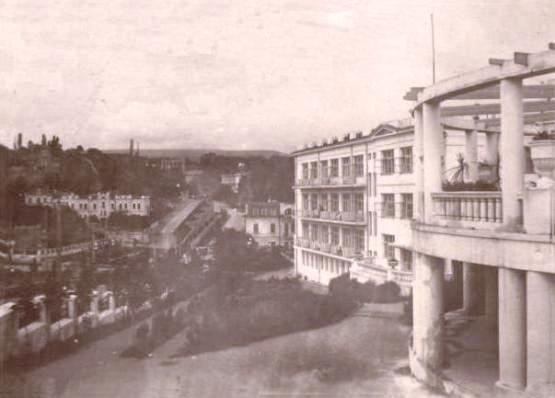
Kislovodsk, a spa town in the North Caucasus, Stavropol region in the year 1942. It is situated 65 km from Elbrus. For a very pleasant climate among the limestone hills, until 1917 there was the Russian aristocracy and intelligence. In the years 1942-1943 here were the officers and soldiers of the Wehrmacht and its allies.
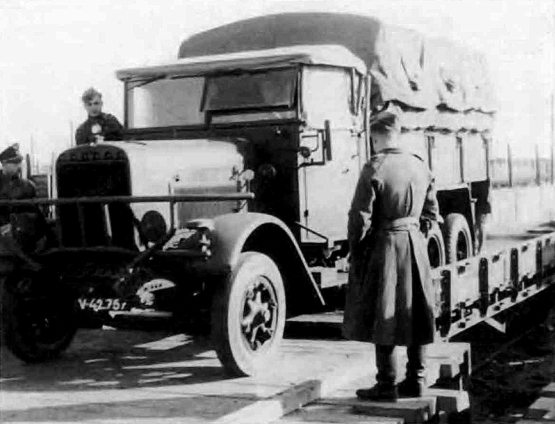
Military off-road trucks Henschel 33 D1 supplied Rapid division (1st Infantry Division) Oberkommando des Heeres OKH (the Supreme High Command of the German Army). Have integral winch which has proven as well as strips for the rear axle. Assembled using the jack. In North Caucasus from 27 October 1942 he was with Rapid Division deployed II/11th Artillery Section 11th Artillery Regiment with the armament of German origin. Battery 4/II, 5/II and 6/II with howitzers leFH.18 (lightweight Feldhaubitze 18) pulled the truck Henschel 33 D1.
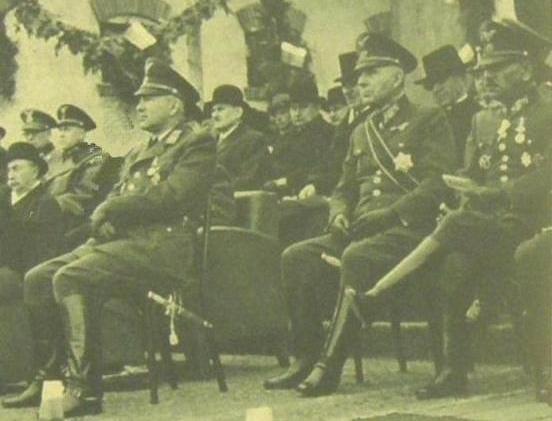
Minister of Defense of the Slovak Republic, General Ferdinand Čatloš, in the spring of 1943, has already accurately estimated the development of the fronts and saved the material and human resources of the state for his intentions. With representatives of the Ministry of National Defense and other guests he attended the ceremonial decommissioning of graduates of the Military Academy 1941-1943 and 1942-1943.
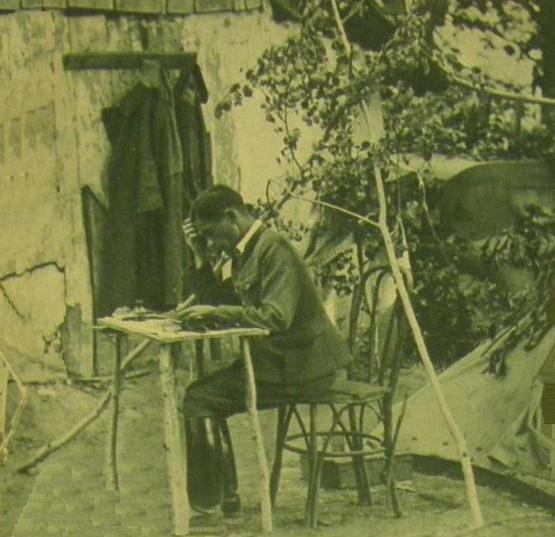
Against the aircraft attacked by the masked car Praga AV on the right, three military mantles vz. 24 hung on the wall of the cottages and on the right on the right is also a well disguised tent.

In its more expensive off-road military vehicles in PAK regarded Lieutenant cavalry Aladár Ondrejkovič vehicles Tatra T 82 for air-cooled engine and three driven axles. Even at 1 July 1943 there were 8 in the state house. In Russian winters, these cars an advantage over water-cooled. Neither of them could compete rasputica Wehrmacht vehicles. In the mud and frost, not fit to start. It will not happen PAK. The climate of Russia revealed other weaknesses of German vehicles (complexity and difficulty of repair expertise to drivers).
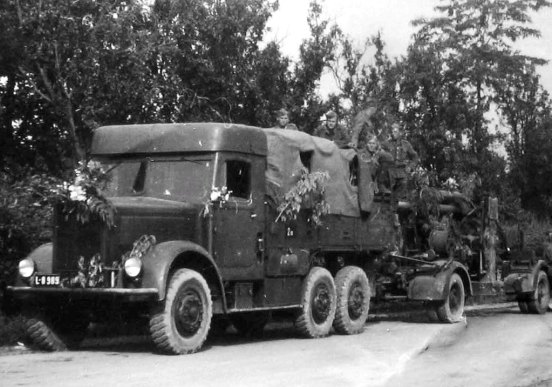
Slovak army in the year 1944. Military truck Skoda 6ST6-L (6x4, load 4t, Otto-engine, 6 cylinders with a 8.2 l, 100) and feared Flak 88. The Caucasus in the deployment section I/11 from 11th Artillery Regiment of Fast Division on October 27, 1942 pulled the cannon Mk 35
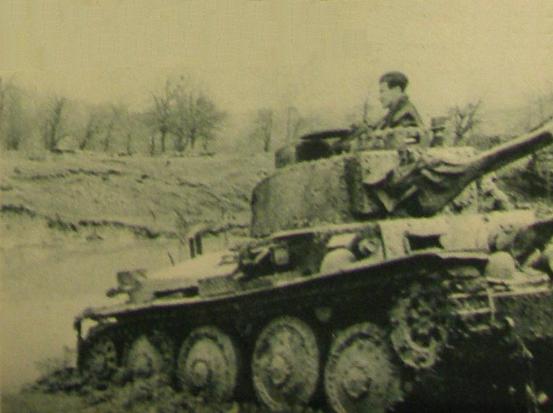
In autumn 1942, they rushed to the North Caucasus and fogged. In the sprawling terrain, the Fast Division Moving Vehicles were also equipped with heavy machinery. They only partly replaced Praga Lt 38 tanks, several belt tractors and horse patches.
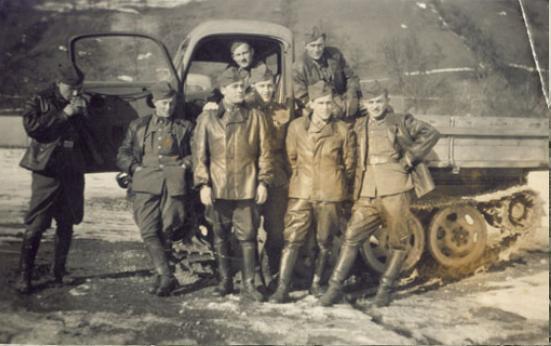
Tracked artillery tractor Steyr RSO (470/01) Raupenschlepper Ost produced in the Steyr-Daimler-Puch AG was included in the Corps automobile park of the Slovak army. Was constructed on the basis of the Soviet tracked artillery tractor Stalinec STZ - 5 which is excellent proved in Fast-division on the Eastern Front. This was put directly into Trafic automobile columns which vehicles assist in the process especially in the Rasputitsa.
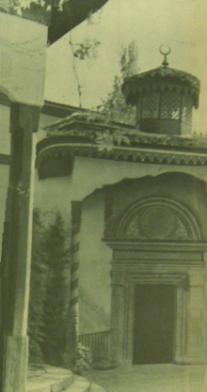
The seat of the Khan Bachchisaraj in the Crimea in the summer of 1943 when it was visited by the Rapid Division officers, including the Lieutenant cavalry Aladár Ondrejkovič.
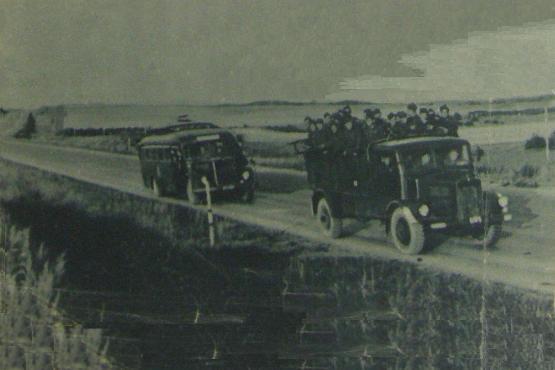
The members of the Front Theater SVŠ were also classmates Magdalen, the sister of Lieutenant cavalry Aladár Ondrejkovič. At the command of the commander, he assigned the Front Theater Bus of the Slovak Railways and trucks PAK with the drivers to transport them to the towns and villages where the Rapid Division units were deployed. The ensemble also performed at Simferopol's Rushkin Theater. The theater returned to Slovakia on 13th August 1943.
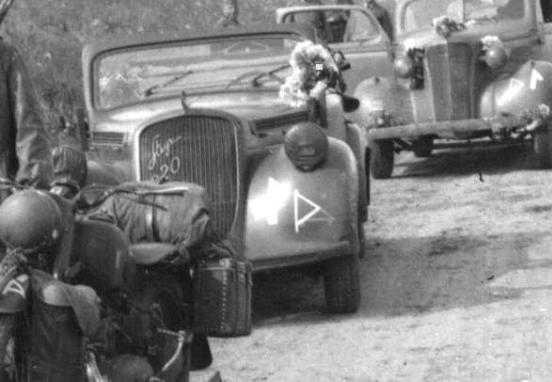
In the summer of 1943 was Rapid division in the state fleet 20 cars Steyr 220. On 12 September 1943 Commander of the 1st Infantry Division (RD) had relegated to Slovakia and 5 motorcycles, including the DKW 350.
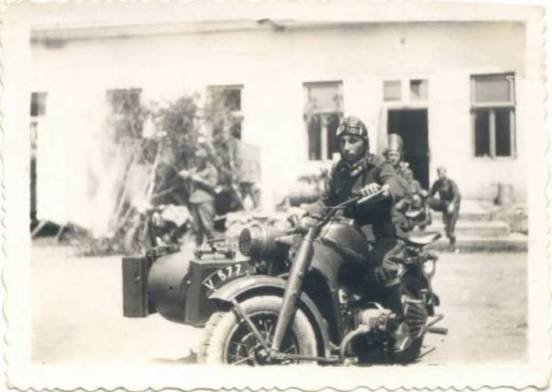
Fast Division had in its fleet of 59 sidecar motorcycles including the BMW R75.
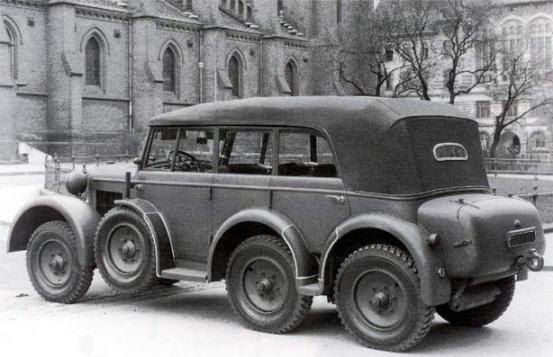
Two command cars Steyr 40 D took 1st Infantry Division (Fast Division) by the end of 1943 september OKH Crimea in Simferopol to replace vehicles taken Wehrmacht in the North Caucasus.
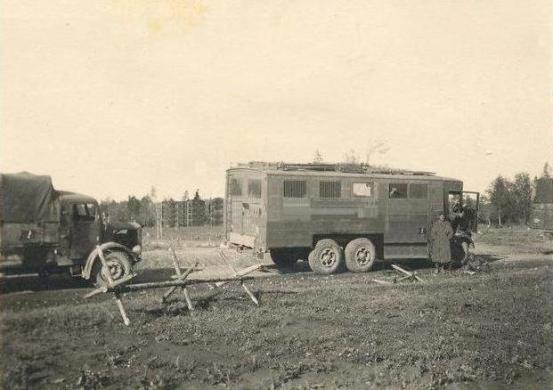
Military terrain Tatra T 29 was between vehicles of learning for railway transport to Slovakia, mentioned in Protocol von commander PAK lieutenent cavalry Aladár II. Ondrejkovič of 12 September 1943. On the date 18.03.1939 Slovak army took over the assets of the military administration Czechoslovakia 8 Complete mobile workshop Tatra model 29.
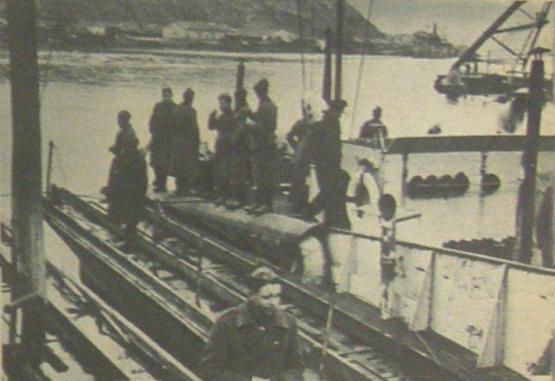
Loading of the Slovak military material of the 1st Infantry Division by harbor cranes in April 1944 for the transfer of the Deutsche Kriegsmarine MTF. In contrast to later information through the cargo ports on the Southwest coast of the Crimea, most of its equipment, supplies and means of transport that were not displaced in 1943 were evacuated.
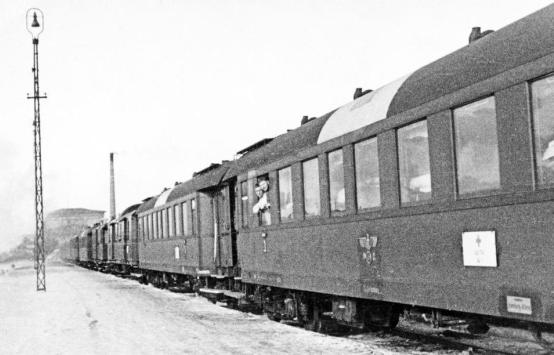
The wounded and sick soldiers of the Rapid Division were transported from the queue hospital train to a military hospital in Vienna, where their officers were taken over their tribal units and vehicles, ambulances transported them to a military hospital in the Bratislava.
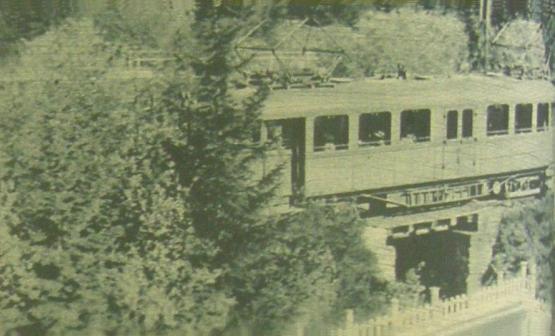
Tatra Military Home, Tatra Tramway in Tatranská Polianka near Novy Smokovec. In the Military House, First lieutenant Aladar Ondrejkovič, after returning from the Eastern Front, had a compulsory resuscitation stay with complete medical examinations.
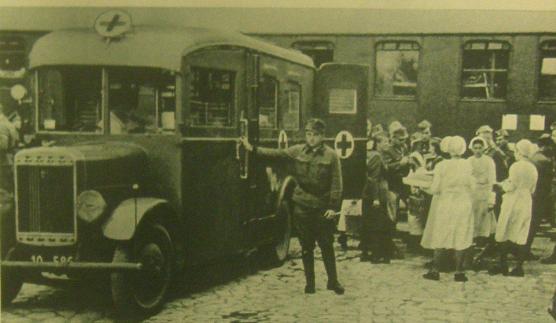
Even First lieutenant Aladár Ondrejkovič, after returning from the Eastern Front, went on his way to Vienna with a Skoda 256 ambulance car with a driver to take over the wounded and sick members of the Fast Division. They worked in the Slovak Red Cross and were also members of his cousin Gizelle and Kamila.

Based on mobilization First lieutenant advance Aladár II. Ondrejkovič enlisted 12th April 1945 walking across the mountains to the refill center of the 1st Czechoslovak Army Corps in the barracks of the 1st Regiment of the assault chariot Turčiansky Saint Martin (OVVS). Received a British battledress, was vetted and sent to OVZS to the Automobile Center in Nitra, where until 1.IX.1945 held the position of commander of the park company eye and others with military trucks Studebaker US6. With them in the autoclave arrived to his former crew of Vysoké Mýto.
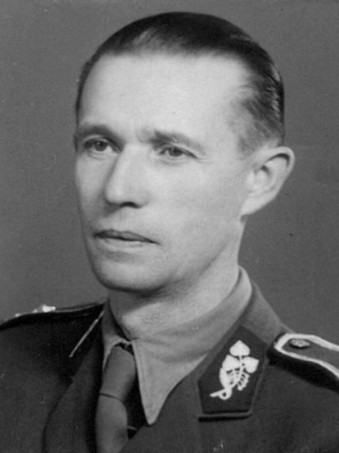
Brigadier General Ján Malár was admitted to the restored Czechoslovak army as Lieutenant Colonel of the Tank Army. On April 2, 1946, he was promoted to Colonel Tank. From October 17, commander of the tank units of the 4th Military Area, where the agenda of the automobile troops was led. He was commander of the Captain tank Aladar II. Ondrejkovič, who was his adjutant and referent of tank units 4th MA since 1.IX.1945. However, they came into service even before 1938 in Motešice. They also often met as rivals in military riding competitions. He was a member of the Commission of High Officers, who assessed the suitability of Elizabeth Ondrejkovičová born Ličková as the wife of a professional officer under order by the Ministry of National Defense A-XIV.
Lieutenant Colonel Ján Malar's brother, General of 2nd Class Augustin Malar, was commander of Lietenant cavalry reserve Aladar II. Ondrejkovič on the Eastern Front in RD in 1941-1942. He expressed his satisfaction with the performance of his service and recommended him in 1941 as a professional officer and study at the Military Academy.
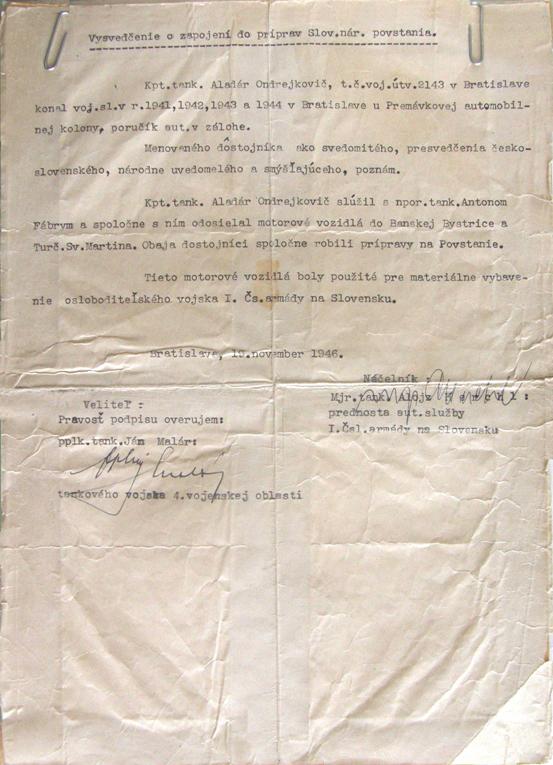
Evidence of involvement in the preparations for the uprising Cpt. tank Aladár II. Ondrejkovič issued on 19 November 1946 the principals of Automotive Service 1st Czechoslovak Army in Slovakia Major tank Alojz Herchl and commander of a tank army of 4th military region Lt. colonel tank Ján Malár.
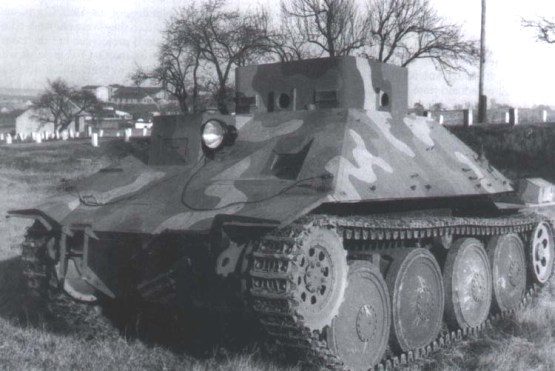
Trainer tank destroyer ST-III is where over 1945 instructor led courses renewed Czechoslovak Army Cpt. tank Aladár Ondrejkovič II in several military garrisons. During his service in the automotive fleet corps instructor led courses crews light tanks Praga LT-38 and tank destroyer ST II Marder of Slovak army.
Notes: Order the Head of Department of the Ministry of National Defense Colonel artillery Josef Turanec the mandatory participation of all officers and sergeants in the Ministry of National Defence at a rally to mark the birthday of Adolf Hitler on 20.04.1940, reference number 155 542 ; Colonel infanery Pavel Kuna From 01 01 1944 head of the military administration of NGOs in Bratislava, 19 05 1944 shifted to Trenčianske Teplice ;
Sources: Colonel Josef Turanec - Journal de guerre (20.06.1941-19.09.1941), art. 95-96. , VHA, f. RD, SK 96, No. j. 318-604, 20 Inf. Regiment, Com. 1st Inf. Division, No. : 100.34/Sec. 4 Teil.1 943, afin de fonctionnement 24, part II SV 24.sept.1943, p.3., Lieutenant-colonel tank Aladár II. Ondrejkovič ;


 back
back 
